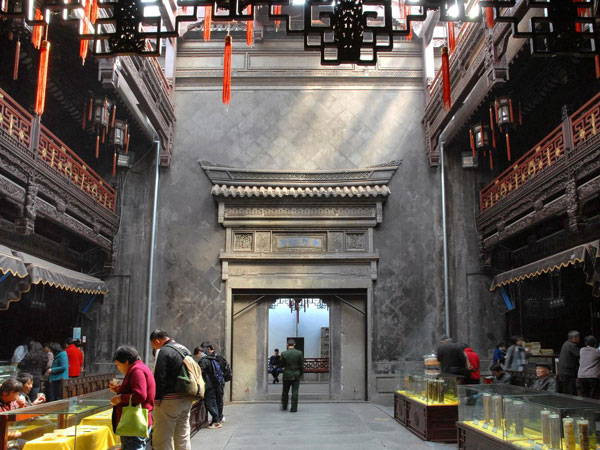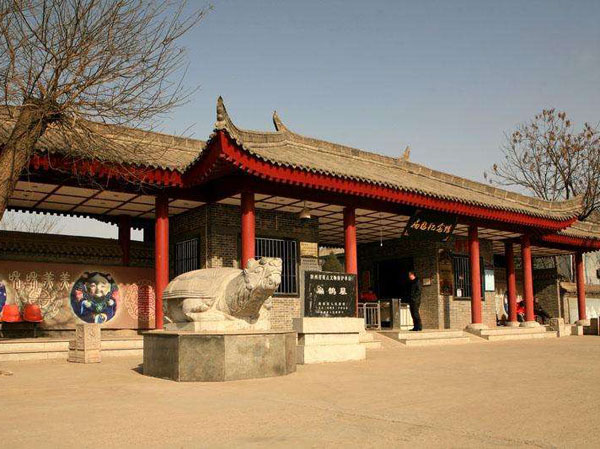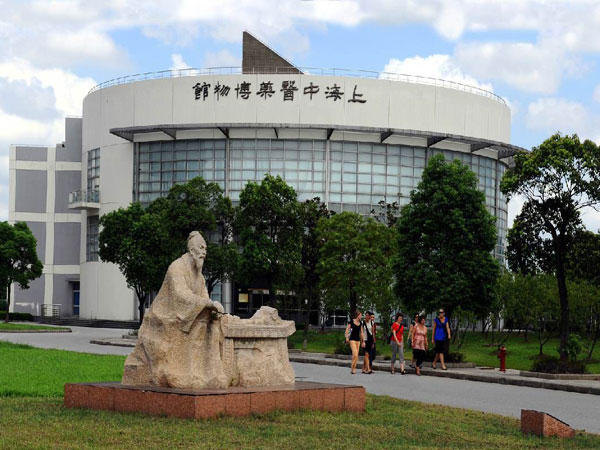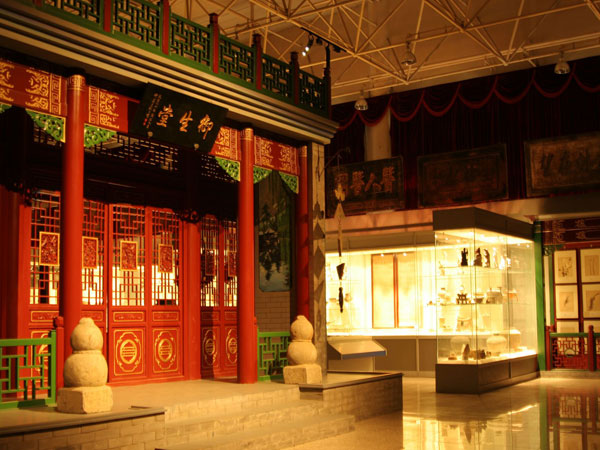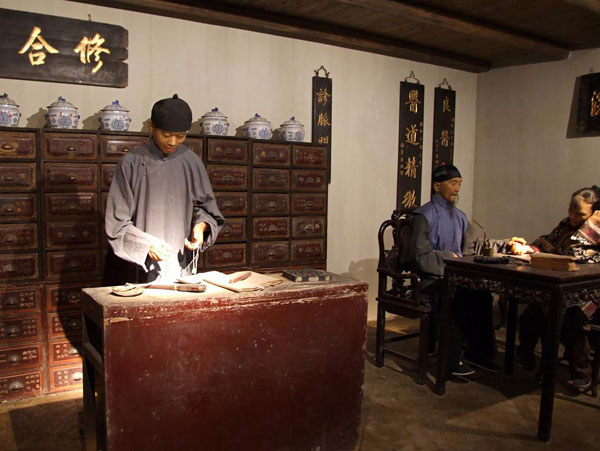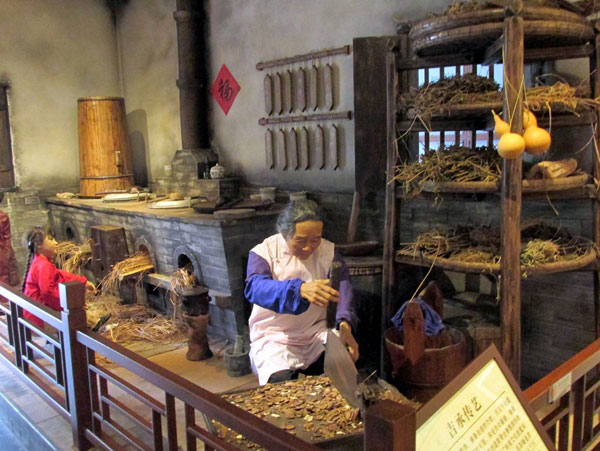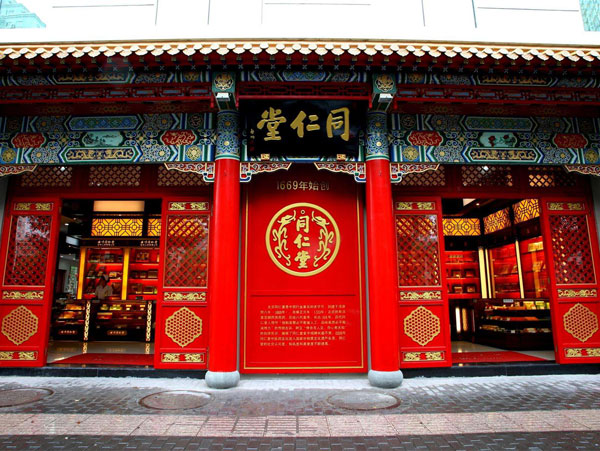Traditional Chinese Medicine, TCM for short, was created by ancient Han people and has been popular in the country for thousands of years. Based on the ancient oriental philosophy, yin and yang theory, the five elements theory and the natural laws of human body, traditional Chinese medicine specializes in physiological monitoring, and the precaution, diagnose and treatment of diseases. Chinese medicine in Japan, Korean medicine in Korea, East medicine in Vietnam was originated from China. In nowadays, TCM has been spread to the world and has special effects on some kinds of disease. To commemorate the famous ancient doctors of TCM, keep the TCM classics, and inherit the essence and therapeutic methods of TCM, many museums of traditional Chinese medicine have been built in China and open to the public.
Hu Qing Yu Pharmacy (Hu Qing Yu Tang) in Hangzhou
It was initially founded by Hu Xueyan who was a successful businessman and a high-ranking official in the Qing imperial court. Starting business in 1874 during the reign of Emperor Guangxu, Hu Qing Yu Tang is still open today, and known as “King of Medicine” in South China. Ever since its opening, Hu Qing Yu Tang has inherited the pharmaceutical techniques and industry standards of Song Dynasty (960 – 1279). Rather than a pharmacy, it is more like a museum of traditional Chinese medicine, with aged talented pharmaceutical artisans, many ancient prescriptions and secret prescriptions, and treasures of Chinese medicine.
Located besides West Lake, at the foot of Wu Mountain, Hu Qing Yu Chinese Pharmacy attracts thousands of visitors every year for its valuable collections, unique cultural atmosphere and magnificent architectural complexities.
Address: inside the History District on Qinghefang Street, surrounded by pedestrian street, Hangzhou, Zhejiang Province
How to get there: Take bus no. Y8, Y10, 13/K13, 25, 35, 51 (Inner Line), 71/K71, 87/K87, 108, 187, 212, 327 or 992, and get off at Wushan Station. Then walk toward east along Hefang Pedestrian Street around 601 yards (550 meters), and then you’ll find the museum.
Hu Qing Yu Tang TCM Museum
Bian Que Memorial Hall in Xi’an
In the long history of traditional Chinese medicine, Bian Que is a household name. Bian Que was born in the Spring and Autumn Period (770BC-476BC), when “a hundred schools of thought contended”, talents in different fields seek opportunities to fulfill their ambitions. Bian Que traveled through the several vassal states, practiced medicine and saved many lives.
Located in Lintong District, Xian City, the museum was converted from the site of Bian Que tomb, and has several halls, to introduce the development of traditional Chinese medicine from the early ages to the late Qing Dynasty, display valuable herbal medicine, more than 800 pieces of cultural relics about the proved recipes, diagnose, treatment, and classical TCM apparatus and instruments, such as scalpel, surgical instrument, acupoint-marked bronze figure, pharmaceutical stove…
Opening hours: 08:00am – 18:00pm
How to get there: take the Xian to Terracotta Warriors Museum bus in the city center, and then take Bus No.318 to Nancheng Village.
Bian Que Memorial Hall
Shanghai Museum of Traditional Chinese Medicine
It is an epitome of the historical development of TCM and made up of TCM History Museum, the Chinese Medicine Specimen Museum and the Institute (Shanghai University of Traditional Chinese Medicine) History Museum, with a construction area of 6413m2 and exhibition area of 4000m2. Shanghai Museum of TCM is an educational base in Shanghai and an ideal place for science tour in Shanghai.
Built in 1938, the TCM History Museum is the first of its kind in China, with collections of over 1400 TCM historical relics dating as far back as the Neolithic Age, over 6000 Chinese medical classics including The Yellow Emperor’s Internal Classic, Compendium of Materia Medica (Ben Cao Gang Mu), and Treatise on Febrile Diseases, and over 3000 Chinese medicine journals and magazines. There are five halls, the comprehensive hall, the health cultivation and rehabilitation hall, the acupuncture, moxibustion and massage hall, Chinese medicinal formulae hall, TCM culture hall and TCM science and education hall.
The Chinese Medicine Specimen Museum displays more than 3000 herbal medicine specimens, such as musk, wild mountain ginseng, cordyceps sinensis, and introduces the functions and knowledge of the herbal medicine.
Opening hours: Tuesday – Sunday, 09:00am – 16:00pm, closed on Mon
Address: 100 Cailun Lu, Pudong New Zone, near Jinke Lu, (inside Shanghai University of TCM)
Shanghai Museum of TCM
Traditional Chinese Medicine Museum affiliated to Beijing University of Traditional Chinese Medicine
Built in 1990, the TCM museum in Beijing is made up of the Chinese Medicine Specimen Museum and Chinese Medical History Museum. By visiting the museum, visitors will meet the legendary doctors of ancient China, Bian Que, Hua Tuo, Zhang Zhongjing, Sun Simiao, Li Shizhen…, and explore the mysterious and profound Chinese medicine. There are approximately 1000 collections of ancient TCM relics, pictures, medical appliance, books, and thousands of precious medicine specimens in its TCM history museum and specimen museum.
Address: No. 11 East Road of the North Third Ring Road, Beijing (north exit of Heping Street)
Opening Hours: 8: 30-11: 30, 13:30-16:30 Tuesday and Friday (except festivals and holidays)
How to get there: Take Bus No.13, No.62, No.119, No.300, No.367, No.407, No.117, No.406, No.419, No.606, No.718, No.725, No.713, No.801, No.825, No.835, No.847, No.967 to get off at the north exit of Heping Street.
TCM Museum
Suzhou Museum of Traditional Chinese Medicine
Converted from the Ci Xian Hall, the residence of Shen Shixing, the Number One Scholar in Ming Dynasty, Suzhou museum of TCM was opened in 2002 and specializes in the traditional Chinese medicine of Wu Area (mainly Suzhou and Wuxi). Chinese medicine in Suzhou is an important part of Wu Culture, and known as Wumen medical school. It was originated in Yuan Dynasty, and reached its heyday in Ming and Qing dynasties. In history, there were about a thousand famous doctors and around a hundred imperial physicians of Wumen medical school, with more than 500 important medical books. The museum is divided into five separated halls, with Chun Hui Hall as the main hall, to display the cultural and historical data of TCM, the ancient medical appliances, the TCM classics, the pharmaceutical equipments and the herbal medicine specimen of Wumen School. The museum is built like a classical Chinese garden, with artificial hill, pool, pavilion, porch, winding corridor, plants…
Address: 314 Jingde Road, Pingjiang District, Suzhou
Museum of TCM
Guangdong Museum of Traditional Chinese Medicine
The museum was initially established in 1996, and reopened to the public in 2006 as part of Guangzhou University of TCM. It is made up of the University history museum, TCM history museum with over 5000 TCM relics, Chinese medical specimen museum, and a 55000-square-meter herbal medicine plantation.
Address: No.232 East Road of Outer Ring University Town, Panyu District, Guangzhou
Opening Hours: 9:00-16:30 from Monday to Friday, reserved group activity on Saturday, and close on Sunday
How to get there: Take University Line 1, Bus No.2 or No.3 to reach the museum.
Guangdong Museum of TCM
Beijing Tong Ren Tang Chinese Medicine
Founded in 1669, the eighth year of the reign of Emperor Kangxi in Qing Dynasty, Tong Ren Tang used to serve medicine to the royals and nobles for 188 years. In nowadays, it still concentrates on the high quality Chinese herbal medicines, and has open stores in 15 countries and regions. Tong Ren Tang and Hu Qing Yu Chinese Pharmacy are the two most famous Chinese medicine pharmacies in China. The traditional Chinese medicine culture of Tong Ren Tang was listed as a national intangible cultural heritage in 2006.
Beijing Tong Ren Tang

